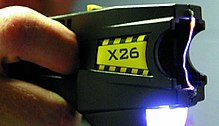This article has multiple issues. Please help improve it or discuss these issues on the talk page. (Learn how and when to remove these messages)
|



A TASER is a conducted energy device (CED) primarily used to incapacitate people, allowing them to be approached and handled in an unresisting and thus less-lethal manner. Sold by Axon, formerly TASER International,[1] the TASER fires two small barbed darts intended to puncture the skin and remain attached to the target until removed by the user of the TASER device, at a speed of 55 m/s (120 mph; 200 km/h). Their range extends from 4.5 m (15 ft) for non-Law Enforcement Tasers to 10.5 m (34 ft) for Law Enforcement Tasers. The darts are connected to the main unit by thin laquer insulated copper wire and deliver a modulated electric current designed to disrupt voluntary control of muscles, causing "neuromuscular incapacitation." When successfully used, the target is said to have been "tased". The effects of a taser may only be localized pain or strong involuntary long muscle contractions, based on the mode of use and connectivity of the darts.[2]
In the United States, TASERs are marketed as less-lethal, since the possibility of serious injury or death exists whenever the weapon is deployed. At least 49 people died in 2018 after being shocked by police with a Taser.[3] Personal use TASERs are marketed in the US, but prohibited in Canada. In Canada, all taser possession is considered illegal. There is a categorical ban on all conducted energy weapons such as stun guns or tasers, according to section 84 of the Canada Criminal Code. TASERs in Canada are only legal for Law Enforcement users.
The first TASER conducted energy weapon was introduced in 1993 as a less-lethal force option for police to use to subdue belligerent or fleeing suspects, who would have otherwise been subjected to more lethal force options such as firearms. As of 2010[update], according to one study, over 15,000 law enforcement and military agencies around the world used tasers as part of their use of force continuum.[4]
A 2009 report by the Police Executive Research Forum in the United States found that police officer injuries dropped by 76% in large law enforcement agencies that deployed taser devices in the first decade of the 21st century compared with those that did not use them at all.[5] Axon and its CEO Rick Smith have claimed that unspecified "police surveys" show that the device has "saved 75,000 lives through 2011."[6][7] A more recent academic study suggested police use of conducted electrical weapons in the United States was less risky to police officers than hands-on tactics, and showed officer injury rates equal to use of chemicals such as pepper spray.
- ^ "TASER X26". Archived from the original on September 27, 2014.
- ^ "Neuromuscular Incapacitation (NMI)", TASER International, published March 12, 2007. Retrieved May 19, 2007 Archived April 13, 2008, at the Wayback Machine
- ^ Cite error: The named reference
:0was invoked but never defined (see the help page). - ^ Cite error: The named reference
policeusewas invoked but never defined (see the help page). - ^ Taylor B (September 2009). "Comparing safety outcomes in police use-of-force cases for law enforcement agencies that have deployed Conducted Energy Devices and a matched comparison group that have not: A quasi-experimental evaluation" (PDF). National Institute of Justice.
- ^ Roberts D. "A new life for Taser, this time with less controversy". Fortune. Retrieved September 14, 2011.
- ^ "Taser.org".